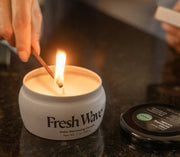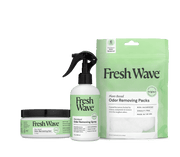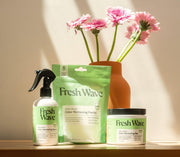There are many ways to achieve serenity at home. Some carve out a quiet space for reading or meditating, others paint the walls their favorite color and let in the natural light. Whatever your chosen method, creating a healthy environment at home is important for your health and mental clarity.
While it can be nice to build a happy environment at home through feng shui, it’s also important to make home improvements at a level we rarely think about: our home’s air quality.
To find out more about natural ways to clean air in a home while eliminating unwanted order, check out these tips from the experts at Fresh Wave.
How to Clean Air in Your Home Naturally
- Add houseplants to clean the air.
- Use salt and beeswax candles as natural air purifiers.
- Improve air quality with plant oils
How Does the Quality of Indoor Air Impact Our Health?
Just as certain odors in the fridge can make us hold our nose, pollutants can have similar effects on the brain and our day-to-day health. In the case of foul odor, when you detect an odor, your brain is picking up on chemical change in the air around you. While these volatile molecules can be unpleasant and bothersome, they aren’t necessarily dangerous.
Pollution, on the other hand, is sometimes composed of small particles of matter, that, when inhaled, can reach the olfactory cortex in our brain and cause headaches, mind fog, and irritability. Short term exposure to these air impurities won’t have profound negative effects on health, but long term exposure can.
That’s why it’s so important to purify the air in the places where we spend the most time and a great place to get started is at home.
Using Plants to Naturally Purify Air at Home
If purifying air through gadgets or technology isn’t your preference and you’re more curious about how to clean the air in your home naturally, take a cue from energy-efficient buildings around the world and use plants. To get started, pick a high traffic room and measure its natural light.
On the next sunny day, place a piece of white paper in the area where you intend to put your plant and hold your hand one foot above it. If your shadow is crisp and clear and you can visibly see each finger, this area receives bright, direct light. If your shadow’s edges are blurry or you can’t make out individual fingers, this area receives medium to low light.
Once you know the kind of light available in your room, you can start looking for plants. For rooms with bright, direct or indirect light, you might want to consider a plant like a majesty palm or aloe. For rooms with more medium light or filtered bright light, you might want to pick a fiddle leaf fig or a trailing pothos plant. And for rooms with low light, you should consider a hardy snake plant or a couple of spider plants.
One of the benefits of placing plants in high traffic areas throughout your home is they’ll start converting CO2 and air impurities into clean oxygen. Additionally, you’ll see how the plant responds to different watering schedules and get a better sense of the type of care it needs to flourish. And while plants are a great home remedy to purify air, they do require a fair amount of care and may not be fitting for individuals that are away from home for long periods of time.
Using Salt to Purify Air
A great alternative to houseplants and another natural way to clean air in your home is to purchase a salt lamp. Salt lamps have recently gotten very popular, and for good reason. Himalyan pink salt is good for more than for just cooking.
Similar to plants, salt also naturally purifies air. While plants absorb CO2, salt removes contaminated water molecules in the air through a process called hygroscopy. This process helps filter dust and bacteria out of the air, and can even help relieve symptoms from seasonal allergies, the common cold, and mild asthma .
Salt lamps work great tucked away in a bookshelf or on display on a nightstand. Their sculptural appearance makes a great addition to any home’s decor, and, when left on, they produce a warm, natural light that is unobtrusive to sleep. Himalayan salt is a great home remedy to purify air and elevate your decor, but it won’t necessarily help get rid of common household odors.
Burning Beeswax Candles to Remove Odors from Indoor Air
To eliminate common household odors, consider burning beeswax candles. Since beeswax is natural, it does not release toxic compounds into the air like benzene or toluene which is a common byproduct of many scented candles.
The line of Fresh Wave Odor Eliminating Candles do not contain parabens, phthalates, sulphates, and burn cleanly, removing unwanted odors in the air and leaving your room smelling fresh and clean. Beeswax and paraben-free candles are an easy home remedy to remove odors and create a wonderful ambiance.
Use Plant-Based Odor Removers to Refresh Your Spaces
Scientists and studies have shown that smells can make you sick. There’s even a condition called sick building syndrome, where the air quality of an environment can cause intense side effects, like respiratory issues, headaches, or nausea. Even products intended to help, namely scented air fresheners or cleaning products, can leave behind lasting odors that can do serious harm.
Plant-based odor removers, like Fresh Wave, leverage the natural power of pine needles, cedarwood, lime, anise, and clove to absorb and neutralize odor molecules in the air. This makes Fresh Wave Odor Eliminating Spray an ideal room refresher, because of its effectiveness at getting rid of lingering smells and its safe ingredients. Just spray evenly throughout the room, and allow the oils to go to work. All that’s left is fresh air.
To learn more about Fresh Wave and the many ways our natural odor eliminating productscan be used throughout the home, check out our tips on where to use Fresh Wave. You’ll learn more about our mission to create a safer, fresher world one home at a time.









